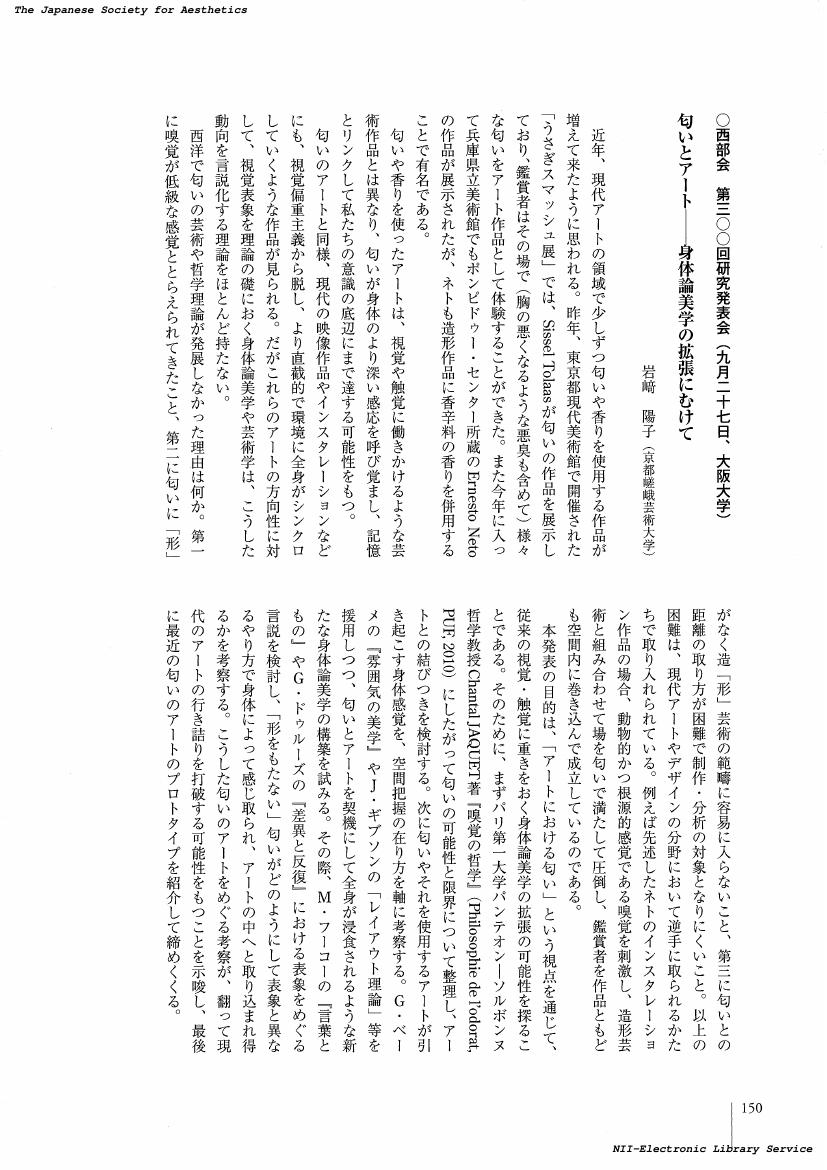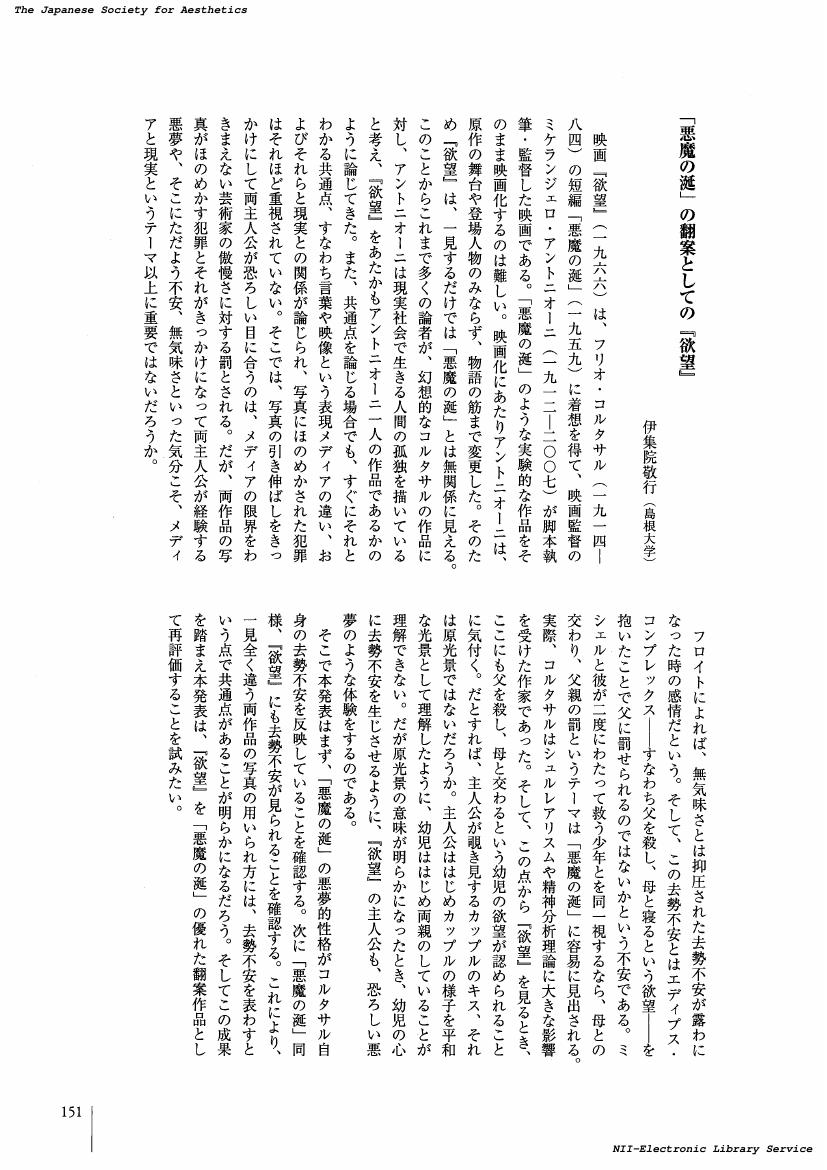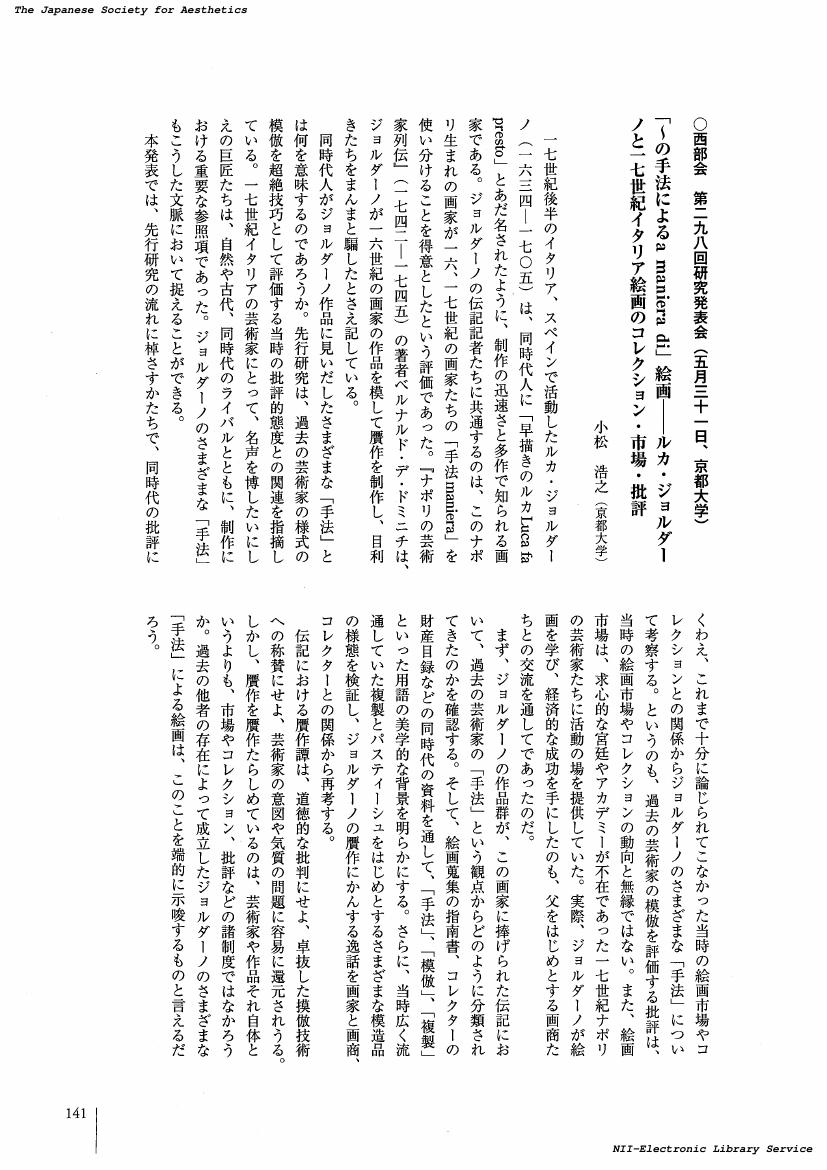- 著者
- 藤阪 新吾
- 出版者
- 美学会
- 雑誌
- 美学 (ISSN:05200962)
- 巻号頁・発行日
- vol.66, no.1, pp.210, 2015-06-30 (Released:2017-05-22)
1 0 0 0 OA 感性からの発意「都市と建築の美学 新国立競技場問題を契機に」(<特集>都市と建築の美学)
- 著者
- 中谷 礼仁
- 出版者
- 美学会
- 雑誌
- 美学 (ISSN:05200962)
- 巻号頁・発行日
- vol.66, no.1, pp.30-40, 2015-06-30 (Released:2017-05-22)
1 0 0 0 OA コンディヤック『人間認識起源論』における分析的方法 : 想像が支える真実らしさの論理
- 著者
- 小田 昇平
- 出版者
- 美学会
- 雑誌
- 美学 (ISSN:05200962)
- 巻号頁・発行日
- vol.66, no.1, pp.41-52, 2015-06-30 (Released:2017-05-22)
Dans l'analyse, qui est la methode de Condillac, nous constatons une double operation : la (re)composition et la decomposition. Pour cette double operation, bien qu'il s'appuie sur la definition de la methode analytique de Newton dans l'Opticks, il doit en outre s'aider de l'experience de la pensee afin de decomposer l'esprit humain. Dans l'Essai, il emploie ≪la double histoire des operations de l'ame et de l'usage des signes≫ et cette adequation est garantie par la vraisemblance engendree par la fiction. Pour Condillac, des lors que la fiction et la vraisemblance sont tirees de l'imagination, fonction permettant de depister ce qui est absent, la decomposition est alors possible. Or, comment la (re)composition devient possible ? Condillac ne donne aucune explication a ce sujet dans l'Essai et emet donc un prejuge. A l'instar de la regle de Descartes, le prejuge de Condillac fait ≪partout des denombrements si entiers, et des revues si generales, [qu'il] fusse assure de ne rien omettre≫. Son prejuge sert de conclusion generale a l'aide de la repetition de l'experience ainsi que de l'observation. Et c'est grace a cela que la (re)composition, en d'autres termes l'analyse (methode utilisee par Condillac), devient envisageable.
1 0 0 0 OA 「われ感ず、ゆえにわれ在り」のヘルダーにおける成立
- 著者
- 杉山 卓史
- 出版者
- 美学会
- 雑誌
- 美学 (ISSN:05200962)
- 巻号頁・発行日
- vol.66, no.1, pp.53-64, 2015-06-30 (Released:2017-05-22)
In On the Sense of Touch and the Fourth Grove of the Critical Forests (both written in 1769, but published posthumously), Herder showed the position "sentio, ergo sum." This paper aims to make clear what led Herder to this position, in order to consider the possibility of "sentio, ergo sum" as an alternative of the Cartesian "cogito, ergo sum." "Sentio, ergo sum" in On the Sense of Touch is, on the one hand, said not only in terms of the "Molyneux's problem," but from the view that it is the highest concept of philosophy to sense the impenetrability of materials, by means of which the precritical Kant, Herder's teacher, criticized the mind-body dualism and claimed to give only the temporary answer "where I sense, there I am." Herder criticized this by the counterexample "mental impenetrability" and upgraded the above "temporary" answer to the "highest concept of philosophy." "Sentio, ergo sum" in the Fourth Grove of the Critical Forests is, on the other hand, the consequence of Herder's formal criticism of Crusius, who criticized "cogito, ergo sum" be "conscius sum me cogitare, ergo sum." "Being" was for Herder the unresolvable concept which we can only sense.
1 0 0 0 OA シュマルゾウ芸術学の哲学的源泉 : 十九世紀における運動と演算
- 著者
- 金田 千秋
- 出版者
- 美学会
- 雑誌
- 美学 (ISSN:05200962)
- 巻号頁・発行日
- vol.66, no.1, pp.65-76, 2015-06-30 (Released:2017-05-22)
This paper attempts to reveal the philosophical origins of August Schmarsow's theorie of arts in Grundbegriffe der Kunstwissenschaft (1905). In the 1870s, young Schmarsow studied philosophy under the direction of Ernst Laas at the University of Strassburg. His doctoral dissertation, titled Leibniz und Schottelius, suggests his specialized knowledge of G.W.Leibniz. Moreover, Laas was a disciple of Adolf Trendelenburg(1802-1872), a now forgotten, but formerly influential professor of philosophy at the University of Berlin. Trendelenburg's philosophy was founded on the premise that every philosophical category is essentially based on the concept of motion. In Grundbegriffe, Schmarsow presented an esthetic doctrine maintaining that the fundamental esthetic categories - symmetry, proportion and rhythm - are founded on the motion of the human body. This paper examines whether Schmarsow's methods were influenced by Leibniz's and Trendelenburg's thoughts.
1 0 0 0 OA アレン・カールソンの自然鑑賞理論における美的性質 : カテゴリーのはたらきに注目して
- 著者
- 青田 麻未
- 出版者
- 美学会
- 雑誌
- 美学 (ISSN:05200962)
- 巻号頁・発行日
- vol.66, no.1, pp.89-100, 2015-06-30 (Released:2017-05-22)
In this paper I will present one interpretation of Allen Carlson's theory for aesthetic appreciation of nature. Carlson claims that we must know commonsense/scientific categories of nature for appropriate aesthetic appreciation of it. There are two intentions behind his statement: one is to make an objective theory for the judgment of nature and the other is to advocate for the assertions of environmentalists on pristine nature. According to these intentions I think Carlson assigns two different roles to those categories, and consequently he assigns two different kinds of aesthetic properties for the same nature through those categories. First, those categories can function to determine the focus of aesthetic appreciation of nature. Here Carlson depends on Kendall Walton's theory of categories of art and applies it to aesthetic appreciation of nature. In this case categories reveal some aesthetic properties that depend on non- aesthetic (physical) properties of nature. Second, categories can function to show the positions of objects in natural order. Through this function categories reveal aesthetic properties that objects can have in relation to natural order. Finally I will point out the difference and similarity of those two aesthetic properties and show the limit of Carlson's view.
- 著者
- 李 惠珍
- 出版者
- 美学会
- 雑誌
- 美学 (ISSN:05200962)
- 巻号頁・発行日
- vol.66, no.1, pp.101-112, 2015-06-30 (Released:2017-05-22)
This article explores the concept of "immanent transfiguration" which was suggested by American philosopher Richard Shusterman. Since Shusterman coined this concept through his critique of Arthur Danto's concept of "transfiguration", it is necessary to clarify the differences between the theories of these two philosophers. Danto made the concept of transfiguration into an elevation of ontological status that turns an ordinary thing into an artwork that enjoys the ontological status of being more than an ordinary "real thing" (TC vii), as Danto explains in his book The Transfiguration of the Commonplace. In contrast, with Shusterman's "immanent transfiguration" the artwork or aesthetic object is still perceived as existing in "our immanent material world" (AAR 14) and the only change in the transfiguration is "a difference of how the same world of things is perceived, experienced, and lived." (AAR 10) However, immanent transfiguration requires a certain condition of consciousness that can be obtained through modes of "hard looking" and "sustained contemplative efforts." One can achieve the experience of transfiguration through such perceptual somaesthetic endeavors. The article concludes by suggesting how Shusterman's reconceptualization of transfiguration is connected not only to the theory of art but also to the more general theory of aisthesis as perception.
1 0 0 0 OA バンベルク大聖堂「君侯の門」彫刻群 : 「神秘の結婚」による終末の花嫁たちの救済
- 著者
- 仲間 絢
- 出版者
- 美学会
- 雑誌
- 美学 (ISSN:05200962)
- 巻号頁・発行日
- vol.66, no.1, pp.113-124, 2015-06-30 (Released:2017-05-22)
The sculptures of Furstenportal of Bamberg Cathedral are one of the representative works of the thirteenth-century German gothic portals. To understand its sculpted program, it is necessary to examine the meanings of unique motifs that remain unclarified in the previous studies, such as the gesture of Proskynesis by the Virgin Mary in the Deesis group and the Arma Christi carriers as the Virgins leading the blessed to Christ on Tympanum, or the monumental representation of female figures of Ecclesia and Synagoga. These motifs could be explained fundamentally in the theological context of bridal mysticism based on the Song of Songs and the Apocalypse. The Virgin Mary's role in Salvation as intercessor is reinforced by her feature as the supreme Bride in Incarnation. Her followers, the Virgins, Ecclesia, Synagoga and the blessed, facing the mercy throne of Bridegroom Christ, are all potential Brides to be saved. Besides the commonly accepted eschatological interpretations, this article argues that the sculpted program depicts mainly the Mystical Marriage and the Salvation of the Brides at the End of Time. In relation to the worship of Cathedral founder "the second Virgin Mary" Empress Cunigunde, her prominent virtue as the Bride of Christ could be emphasized in the main portal of Bamberg Cathedral.
1 0 0 0 OA ヤン・フートのルネ・マグリット解釈 : フートのアート観と「アイロニー」を参照点として
- 著者
- 利根川 由奈
- 出版者
- 美学会
- 雑誌
- 美学 (ISSN:05200962)
- 巻号頁・発行日
- vol.66, no.1, pp.125-136, 2015-06-30 (Released:2017-05-22)
At present, there are two points of view about the interpretations of Rene Magritte(1898-1967), who was the Belgian painter. The former is that Magritte's works have "fantasitic" (fantastique) features in the argument of art history. The latter is that they interpret Magritte as the father of the conceptual art at the U.S.. In order to show another aspects of the acceptance of Magritte, I focus on Jan Hoet's interpretation of Magritte. Hoet is the ex-director of Museum of Contemporary Art Ghent and the international curater. The reason why I refer to Hoet's view is that the argument to Magritte of Hoet insists us that the different interpretation of Magritte with the previous studies. So that, in this thesis, I would like to clear the new aspect of the acceptance of Magritte through Hoet's words and exibitions about Magritte.
- 著者
- 田中 麻帆
- 出版者
- 美学会
- 雑誌
- 美学 (ISSN:05200962)
- 巻号頁・発行日
- vol.66, no.1, pp.137-148, 2015-06-30 (Released:2017-05-22)
Contemporary artist David Hockney's (b. 1937) trips to Japan were connected to the works he created in the 1970s and 1980s. However, prior studies have not analysed these works in detail. This report re-examines Hockney's interest in Japan by collating the Japanese art that he encountered during his travels. Some scholars identify the works that Hockney created after first visiting Japan in 1971 as the impetus for his moving beyond naturalistic composition based on one-point perspective. This report additionally compares his works with Japanese paintings he may have encountered and indicates their similarity in terms of techniques depicting time. In the 1980s, Hockney created collages of photographs, which require time to shift the viewer's gaze across multiple points of focus. He called this visual sense "reverse perspective". Although preceding studies have referenced 'reverse perspective' theory, they have lumped together Chinese and Japanese art. Hockney has stated that his visit to Kyoto's Ryoan-ji Temple inspired his "reverse perspective" theory, the background of which requires further examination. Hockney explained this theory by referring to Chinese scrolls; however, when his works from that period are analysed in detail, they reveal that he might also have gained knowledge from his exposure to Japanese scrolls.
- 著者
- 高木 駿
- 出版者
- 美学会
- 雑誌
- 美学 (ISSN:05200962)
- 巻号頁・発行日
- vol.65, no.2, pp.149, 2014-12-31 (Released:2017-05-22)
- 著者
- 岩崎 陽子
- 出版者
- 美学会
- 雑誌
- 美学 (ISSN:05200962)
- 巻号頁・発行日
- vol.65, no.2, pp.150, 2014-12-31 (Released:2017-05-22)
1 0 0 0 OA 「悪魔の涎」の翻案としての『欲望』(西部会第三〇〇回研究発表会,例会・研究発表会要旨)
- 著者
- 伊集院 敬行
- 出版者
- 美学会
- 雑誌
- 美学 (ISSN:05200962)
- 巻号頁・発行日
- vol.65, no.2, pp.151, 2014-12-31 (Released:2017-05-22)
1 0 0 0 OA 《特集》都市と建築の美学 : 新国立競技場問題を契機に(<特集>都市と建築の美学)
- 著者
- 岡田 温司
- 出版者
- 美学会
- 雑誌
- 美学 (ISSN:05200962)
- 巻号頁・発行日
- vol.66, no.1, pp.2-4, 2015-06-30 (Released:2017-05-22)
1 0 0 0 OA 細粒都市東京とその将来像(<特集>都市と建築の美学)
- 著者
- 槇 文彦
- 出版者
- 美学会
- 雑誌
- 美学 (ISSN:05200962)
- 巻号頁・発行日
- vol.66, no.1, pp.5-12, 2015-06-30 (Released:2017-05-22)
- 著者
- 初田 香成
- 出版者
- 美学会
- 雑誌
- 美学 (ISSN:05200962)
- 巻号頁・発行日
- vol.66, no.1, pp.13-20, 2015-06-30 (Released:2017-05-22)
1 0 0 0 OA 都市とオリンピック : 都市の美学と新たな景観(<特集>都市と建築の美学)
- 著者
- ニリオ オリンピア
- 出版者
- 美学会
- 雑誌
- 美学 (ISSN:05200962)
- 巻号頁・発行日
- vol.66, no.1, pp.21-29, 2015-06-30 (Released:2017-05-22)
- 著者
- 小田部 胤久
- 出版者
- 美学会
- 雑誌
- 美学 (ISSN:05200962)
- 巻号頁・発行日
- vol.65, no.2, pp.140, 2014-12-31 (Released:2017-05-22)
- 著者
- 小松 浩之
- 出版者
- 美学会
- 雑誌
- 美学 (ISSN:05200962)
- 巻号頁・発行日
- vol.65, no.2, pp.141, 2014-12-31 (Released:2017-05-22)
- 著者
- 立野 良介
- 出版者
- 美学会
- 雑誌
- 美学 (ISSN:05200962)
- 巻号頁・発行日
- vol.65, no.2, pp.142, 2014-12-31 (Released:2017-05-22)











